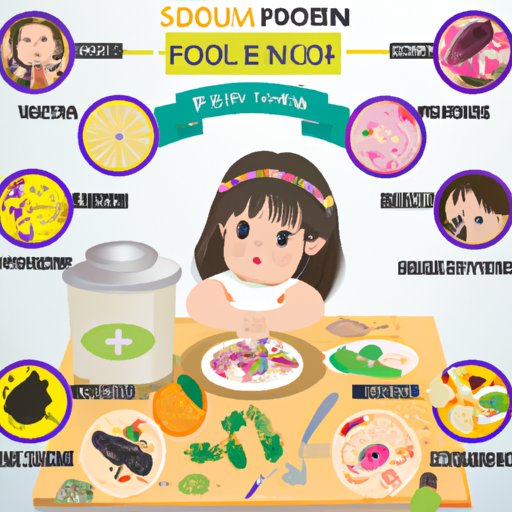Overview of Food Poisoning – What is it and How Does It Work?
Food poisoning is a common illness caused by eating or drinking contaminated food or beverages. It occurs when harmful bacteria, viruses, parasites, or toxins enter the body through contaminated food or water. Food poisoning can range from mild to severe, and in some cases, it can even be life-threatening. Although it is commonly thought of as a single illness, food poisoning encompasses many different types of illnesses and can be caused by a variety of contaminants.

Definition of Food Poisoning
According to the Centers for Disease Control and Prevention (CDC), food poisoning is a “general term that describes any illness caused by eating contaminated food.” The CDC also states that foodborne illness is often referred to as “food poisoning” because the symptoms are similar to those of poisoning. However, it is important to note that food poisoning is not caused by poisons, but rather by bacteria, viruses, parasites, toxins, and other contaminants.
Different Types of Food Poisoning
There are several different types of food poisoning. The most common types are bacterial food poisoning, viral food poisoning, and parasitic food poisoning. Bacterial food poisoning is caused by bacteria such as Salmonella, E. coli, Listeria, and Staphylococcus aureus. Viral food poisoning is caused by viruses such as Norovirus and Hepatitis A. Parasitic food poisoning is caused by parasites such as Giardia and Cryptosporidium.
How Food Poisoning Works
Food poisoning occurs when harmful bacteria, viruses, parasites, or toxins enter the body through contaminated food or water. Once inside the body, these microorganisms can cause inflammation, irritation, and other symptoms. For example, bacteria such as Salmonella and E. coli produce toxins that can damage cells and cause diarrhea, abdominal cramps, and fever. Viruses such as Norovirus and Hepatitis A can cause nausea, vomiting, and diarrhea. And parasites such as Giardia and Cryptosporidium can cause gastrointestinal distress, fatigue, and dehydration.
Causes and Symptoms of Food Poisoning
Food poisoning can be caused by a variety of sources, including contaminated food or water, improper storage of food, cross-contamination of food, and inadequate cooking of food. Common symptoms of food poisoning include nausea, vomiting, abdominal cramps, fever, and diarrhea. In more severe cases, food poisoning can lead to dehydration, organ failure, and even death.

Common Types of Bacteria That Cause Food Poisoning
Bacteria are the most common cause of food poisoning. Some of the most common types of bacteria that can cause food poisoning include Salmonella, E. coli, Listeria, and Staphylococcus aureus. According to the World Health Organization (WHO), Salmonella is the most common cause of food poisoning worldwide, accounting for about 40% of all reported cases. E. coli is another common cause of food poisoning, and it can cause serious illness and even death.
Listeria is a type of bacteria found in soil, water, and animal feces. If left unaddressed, it can cause severe illness in pregnant women, newborns, and people with weakened immune systems. Staphylococcus aureus is a common cause of food poisoning and can cause nausea, vomiting, abdominal cramps, and fever.
Treatment and Prevention of Food Poisoning
Treating food poisoning depends on the cause of the illness. Most cases of food poisoning can be treated at home with rest and plenty of fluids. However, if you experience severe symptoms such as high fever, bloody diarrhea, or dehydration, you should seek medical attention.
The best way to prevent food poisoning is to practice good food safety habits. This includes cleaning and sanitizing surfaces, properly storing and handling food, cooking and reheating food properly, avoiding cross-contamination, and staying up to date on food recalls.

How to Identify the Source of Food Poisoning
Identifying the source of food poisoning can be difficult, as many symptoms can take days or even weeks to appear. If you suspect that you have food poisoning, it is important to keep records of what you ate and drank in the days leading up to your illness. Post-exposure testing may also be necessary to identify the source of the contamination.
Risks of Food Poisoning in Young Children
Young children are especially vulnerable to food poisoning. Their immune systems are still developing, and they may not be able to fight off infection as easily as adults. Additionally, they may not be able to recognize the symptoms of food poisoning or communicate them to their parents. It is important to take special precautions when feeding young children to prevent food poisoning.

Food Safety Tips to Prevent Food Poisoning
Food safety is essential for preventing food poisoning. To keep your family safe, it is important to practice good food safety habits, such as cleaning and sanitizing surfaces, properly storing and handling food, cooking and reheating food properly, avoiding cross-contamination, and staying up to date on food recalls. By following these simple tips, you can help protect yourself and your family from the risks of food poisoning.
(Note: Is this article not meeting your expectations? Do you have knowledge or insights to share? Unlock new opportunities and expand your reach by joining our authors team. Click Registration to join us and share your expertise with our readers.)
